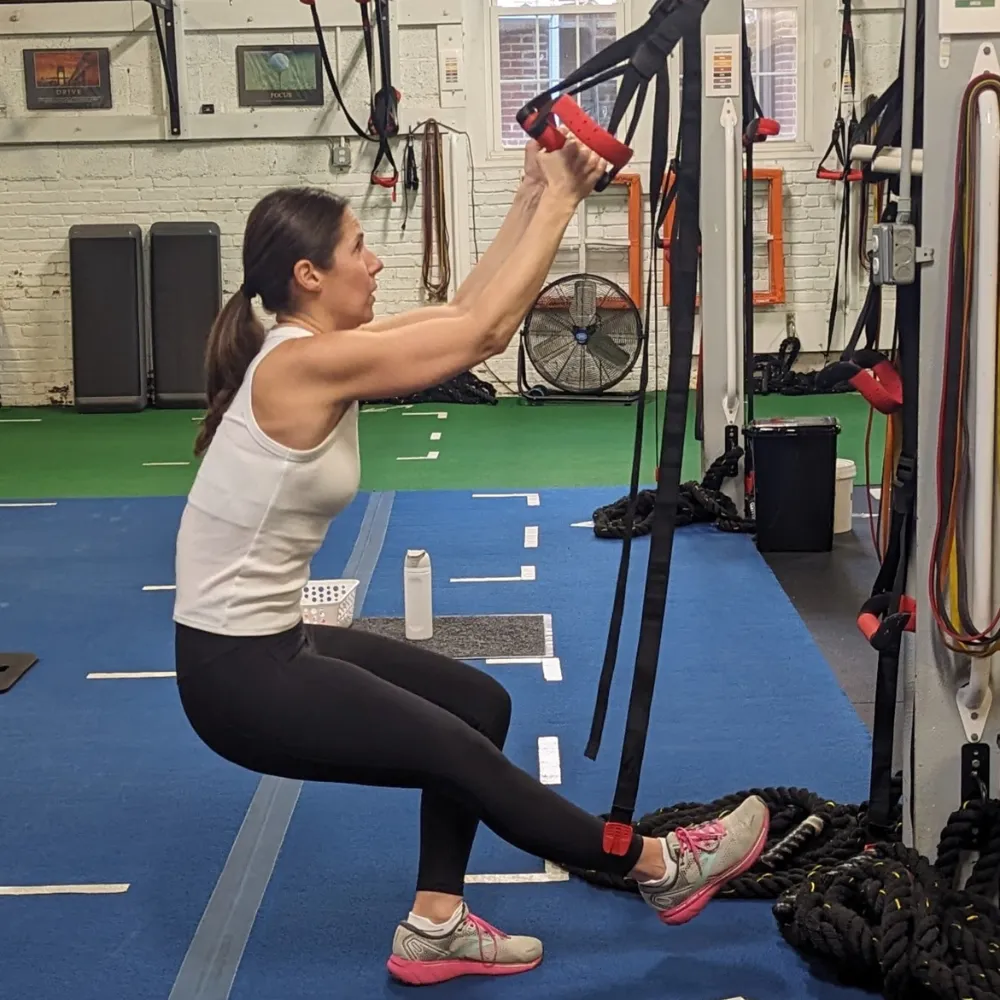PERSONAL TRAINING BLOG

Isometric Training: Rebuild Strength Safely in Havertown, PA
Rebuild Your Body With The Astonishing Power Of Isometric Training
Blog Summary:
Isometric training builds strength without movement, making it ideal for injury prevention and rehab. At Ultimate Wellness Lifestyle in Havertown, PA, we help Drexel Hill and Broomall residents improve mobility and muscle control through training.
Struggling with joint pain, muscle weakness, or limited mobility? Many workout routines involve repetitive movements that can strain your joints, making it harder to stay consistent. Isometric training provides a powerful solution by engaging muscles without excessive motion, reducing the risk of injury. This low-impact yet highly effective method builds strength, improves endurance, and supports rehabilitation. At Ultimate Wellness Lifestyle in Havertown, PA, we help individuals in Drexel Hill, Broomall, and surrounding areas incorporate isometric training into their wellness routines for lasting results.
What Is Isometric Training?
Isometric training is a strength-building technique that involves holding a static position under tension rather than performing continuous movements. Unlike traditional workouts that rely on lifting and lowering weights, isometric exercises engage muscles without changing their length. This method activates muscle fibers at a deep level, making it ideal for building strength, endurance, and stability. Since isometric movements put minimal strain on joints, they are widely used in physical therapy, rehabilitation, and athletic training programs. Whether you're an athlete or someone recovering from an injury, isometric training can be an effective addition to your fitness routine.
Benefits of Isometric Training
Isometric exercises offer numerous advantages beyond just building strength. They help improve muscle endurance, enhance stability, and reduce the risk of injury. Because they require sustained muscle activation, they promote better neuromuscular control, which improves coordination and balance. Additionally, these exercises can be modified for different fitness levels, making them accessible for beginners and experienced athletes alike. Whether you're looking to boost athletic performance or relieve chronic pain, isometric training provides a versatile solution.
Why Isometric Training Is Effective?
Many traditional workouts focus on repetitive motion, which can lead to wear and tear on joints over time. Isometric training, on the other hand, focuses on holding muscle contractions for extended periods, maximizing muscle activation with minimal strain. This unique approach makes it an excellent choice for injury prevention, rehabilitation, and long-term strength building. The ability to perform isometric exercises without special equipment also makes them accessible to people of all fitness levels.
Builds Strength Without Impact
One of the biggest advantages of isometric training is that it helps develop muscle strength without excessive stress on joints. Unlike traditional weightlifting, which involves repetitive movement that can strain tendons and ligaments, isometric exercises engage muscles while keeping joints stable. This makes them ideal for individuals with arthritis, previous injuries, or mobility limitations.
Boosts Muscle Endurance
Isometric exercises train your muscles to hold contractions for longer periods, improving overall endurance. This means you'll be able to perform daily activities—such as walking, standing, and lifting—with greater ease and less fatigue. Over time, consistent isometric training enhances muscular stamina, allowing you to perform both athletic and everyday tasks more efficiently.
Supports Rehabilitation and Pain Relief
Isometric training is widely used in physical therapy and rehabilitation programs to help individuals recover from injuries. Holding controlled static positions helps strengthen weakened muscles without causing excessive movement that could lead to further damage. These exercises also help reduce pain by improving joint stability, making them a great option for those dealing with chronic conditions like knee pain, lower back discomfort, and arthritis.
Isometric Training vs. Traditional Workouts
When comparing isometric training to traditional strength training, it’s important to understand their differences in effectiveness, impact, and accessibility. While both methods can help improve muscle strength, isometric exercises require no equipment, take less time, and reduce joint stress. This makes them particularly beneficial for people looking for a low-risk, high-reward workout solution.
Less Stress, More Strength
Traditional workouts often involve lifting, lowering, or explosive movements, which can put unnecessary stress on the joints and connective tissues. Isometric training, on the other hand, engages the entire muscle without excessive strain, allowing for strength gains without the risk of injury.
Time-Efficient Workouts
Isometric exercises require less time than traditional strength training because they engage multiple muscle fibers simultaneously. For example, holding a plank for 30 seconds can activate your core as effectively as doing 50 crunches. This makes isometric training a great choice for people with busy schedules who still want to see results.
Versatility and Accessibility
One of the biggest advantages of isometric training is that it can be done anywhere, anytime, without special equipment. Whether you're at home, in a hotel room, or at the office, you can perform effective isometric exercises with just your body weight. This makes it a practical solution for those who don’t have access to a gym or prefer a minimalist workout approach.
Best Isometric Exercises for Full-Body Strength
Isometric exercises target different muscle groups, making them an excellent full-body workout option. Whether you’re looking to strengthen your core, arms, legs, or back, these movements will help you build endurance and stability.
Upper Body: Wall Sit and Plank Variations
Wall sits strengthen the quadriceps, hamstrings, and glutes, while plank variations engage the core, shoulders, and arms. Holding these positions for 30-60 seconds can significantly improve muscular endurance and posture.
Lower Body: Glute Bridge Hold
The glute bridge hold activates the glutes, hamstrings, and lower back muscles, improving hip stability and reducing lower back pain. This exercise is especially beneficial for those with sedentary lifestyles or posture issues.
Core Strength: Hollow Body Hold
A staple in gymnastics training, the hollow body hold strengthens the abdominal muscles, lower back, and hip flexors. It enhances core stability, which is crucial for balance, posture, and athletic performance.
How to Incorporate Isometric Training into Your Routine?
Adding isometric exercises to your fitness routine is simple and effective. Whether you’re a beginner or an advanced athlete, following these steps will help you see results quickly.
Start with Short Holds
If you're new to isometric training, begin by holding each position for 10-15 seconds and gradually increase the duration as your muscles adapt. This approach prevents overexertion and muscle fatigue.
Combine with Dynamic Exercises
Pairing isometric movements with traditional strength exercises—such as squats, lunges, or push-ups—creates a well-balanced workout that improves both static and dynamic strength.
Stay Consistent
For the best results, aim to include isometric exercises 2-3 times per week. Consistency is key to building strength, improving endurance, and preventing injuries.
Experience the Benefits of Isometric Training at Ultimate Wellness Lifestyle
At Ultimate Wellness Lifestyle in Havertown, PA, we specialize in helping individuals build strength without impact, reduce pain, and improve mobility through isometric training. Whether you're in Havertown, Drexel Hill, or Broomall, our expert team can guide you through customized workout plans that fit your fitness level and goals.
Ready to Strengthen Your Body?
Take the first step toward a stronger, pain-free lifestyle today! Visit ultimatewellnesslifestyle.com to learn more about our expert-guided fitness programs and start seeing real results.
Ready to build strength without strain? Start your isometric training journey today! Visit ultimatewellnesslifestyle.com and take the first step toward better fitness and mobility.


ARE YOU READY TO INVEST IN YOUR HEALTH AND HAVE A BLAST AT ULTIMATE WELLNESS?!?!
IF SO, CLICK THE LINK BELOW TO LEARN MORE
15 B SOUTH EAGLE ROAD, HAVERTOWN, PENNSYLVANIA 19083
15 B SOUTH EAGLE ROAD,
HAVERTOWN, PENNSYLVANIA 19083
© 2025 Ultimate Wellness
|
|
© 2025 Ultimate Wellness

